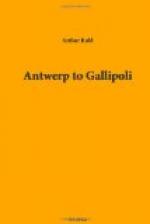We could see the end of the peninsula, where the coast curves round from Eski Hissariik toward Sedd ul Bahr, and two of the enemy’s cruisers steaming slowly back and forth under the cliffs, firing, presumably, as they steamed. Now they were hidden under the shore, now they came in view, and opposite Eski Hissarlik swung round and steamed west again. In front of us, just over the edge of the plateau which there began to slope downward, were the trenches of the Turks’ left wing, now under bombardment. The ridge just hid the shells as they struck, but we could see the smoke from each, now a tall black column, like the “Jack Johnsons” of the west, now a yellowish cloud that hung long afterward like fog—and with it the continuous rattle of infantry fire. Several fliers were creeping about far up against the ’blue, looking for just such hidden batteries as that which kept barking behind us, and out in front and to the right came the low Br—r—um—m! of heavy guns.
Fighting like this had been going on for weeks, the ships having the advantage of their big guns by day, the Turks recovering themselves, apparently, at night. They were on their own ground—a succession of ridges, one behind the other—and they could not only always see, but generally looked down on, an enemy who could not, generally, see them. And the enemy’s men, supplies, perhaps even his water—for this is a dry country at all times, and after June there are almost no rains—must come from his ships. If English submarines were in the Marmora, so, too, were German submarines off the Dardanelles, and if the Turks were losing transports the English were losing battleships.
The situation held too many possibilities to make prophecy safe—I merely record the fact that on the afternoon of May 27 I stood on the plateau above Sedd ul Bahr, and perhaps five miles from it in an air line, and still found myself a regrettable distance from the Allies’ front.
The sun was shining level down the road as we returned to camp, and soldiers were still tramping peacefully up to the front with their kettles of food. Meanwhile the colonel had prepared a little exhibition for us. Six or eight soldiers stood in line, each with a dish and spoon, and in the dish a sample of the food for that night. We started at the top and tasted each: soup, mutton, stewed green beans, new-baked bread, stewed plums, and a particularly appetizing pilaf, made out of boiled whole wheat and raisins. Everything was good, and the beaming colonel declared that the first thing in war was to keep your soldiers well fed. We dined with him in his tent: soup and several meat courses, and cherry compote, and at the end various kinds of nuts, including the cracked hazelnuts, commoner in Turkey than bananas and peanuts at home.
He hoped to come to America some day, and thought we must soon develop the military strength to back our desires for peace, unless there were to be continual wars. New York’s climate, the cost of fruit in Germany, and other peaceful subjects were touched on, and the colonel said that it was an honor to have us with him—ours we brilliantly responded—and a pleasant change from the constant talk and thought of war.




